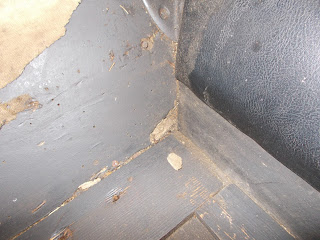I'm going to move ahead with smaller tasks than the heavily damaged back board.
This is the right side board.
I found that the heat gun is THE thing for stripping the thin paint from this project. I can aim the gun directly in front of my putty knife and the paint skins right off like a banana peel.
Finished with 80 grit sandpaper, all surfaces.
Damage assessment:
Rear edge:
Nail holes and cracks
One loose chip
Bottom front:
One large, well adhered chip
Connects with a screw hole
Outer edge:
Heavy upholstery tack damage
Tomorrow is an Abatron day!
Meanwhile...
The step bolts and square nuts (considered essential to a "proper" restoration, where the original nuts were square) arrived and now the seat risers have been permanently reassembled. A small touch that will look really beautiful when the final finishing is done!(Note, finish is protective but by no means "finished!" Much more additional surfacing prior to priming and painting!)
On to seat repairs...
My little repair station is set up (in the kitchen!) This is the right side board. I dealt with nail holes and cracks first, drizzling Liquid Wood onto the end grain until it's fairly well saturated. There is a small loose chip that has been put back in place. The LW will saturate it and stick it back in permanently.
The damaged edge has been heavily smeared with Wood Epox and is curing under the lamp.
The tack holes in the upper edge and a couple of screw holes have also been filled.
Tomorrow there is a substantial, adhered chip on the other end of the board to repair (gravity is against doing everything in one day as the LW runs out of the holes when turned upside down!)
The entire seat is now dismantled (except the bottom boards). The grab handles have gone through the de-rusting bath and are covered with Bondo, awaiting sanding. The corner braces on the seat back are now occupying the derusting bath. Everything is moving along nicely.
WOODWORM
 |
| https://www.wisepropertycare.com/services/woodworm/what-is-woodworm/signs/ |
In all the years I've been trying to learn about carriage restoration, I find it interesting that I cannot recall a single mention of woodworm damage and its repair in the literature.
I have known since the start that this wagon was infested with wood-boring beetle larvae at some point in its history, but the small holes have been painted, the infestation has appeared dead for the 13 years I've owned the carriage. It seemed that the damage was totally superficial.
Until of course, I uncovered the significant damage just under the surface of these seat boards!
So I've gone on a little search to learn more about woodworm.
First of all, I would never bring home another carriage with woodworm, ESPECIALLY one with an active infestation, identified by fine powder around the holes. Woodworm is contagious! To other carriages, to wooden structures... I would never risk it.
As I've found out, a piece of infested wood can look structurally sound on the outside, yet be a honeycomb of tunnels and galleries within.
As I go along with the repairs, I will be thoroughly testing the surfaces of the wood with an awl to discover the extent of any damage I find.
Thankfully, it seems that my choice of repair materials, penetrating epoxy and structural putty, are the repair materials of choice, although I already knew as much.
This morning I went to www.abatron.com and ordered more Liquid Wood, plus a quart of the companion solvent, Abosolv. When I proceed on to the really infested areas, I want to thin the syrupy consistency of the Liquid Wood a bit, so it can really penetrate (not that it doesn't already!).
While I wait for these new materials to arrive, I have plenty of other work to do.
Once again, it might seem like replacing these simple looking boards would be easier. However I have no idea how one would ever be able to copy the angles, arcs and convex surfaces that are not so evident in these photos. To me it is what sets these antique "full lazyback" seats apart from modern construction. Most modern wagons and buggies are built with flat panels. No, these boards are definitely worth saving.
Continued...
The first Abatron edge repair. External view.
No matter how much of the stuff I apply, I always miss a spot. One tiny nick to fix on the next round of repairs!
Internal view, Including a couple of screw holes that need to be re-drilled, plus a tack hole or two.
The loose chip can be seen embedded in putty on the left side.
The holes from upholstery tacks are finished...
After sanding the exterior surface down to 220 grit, I've applied a thin coat of automotive spot putty to fill grain, sanding scratches and other very small imperfections.
The spot putty is sanded back and the piece is coated with clear wood sealer.
Done. (For storage...there are still several surfacing steps before painting!)
Now, on to...
The bottom seat frame.
This is definitely a replacement, made of an inappropriate wood, cedar I think.
Most of the fastener holes are failing. I've already drilled and pegged some of them. The screw holes around the perimeter, I am going to dam up and fill with Liquid Wood. That will strengthen the wood around the holes and stop the splitting. Otherwise, there is just a wee bit of cosmetic work around the edges.
Sanded and ready for TLC.
A rack of hardware, all de-rusted, re-surfaced and primed, drying in front of the fire!
I am awaiting a few supplies before doing much more.





















































